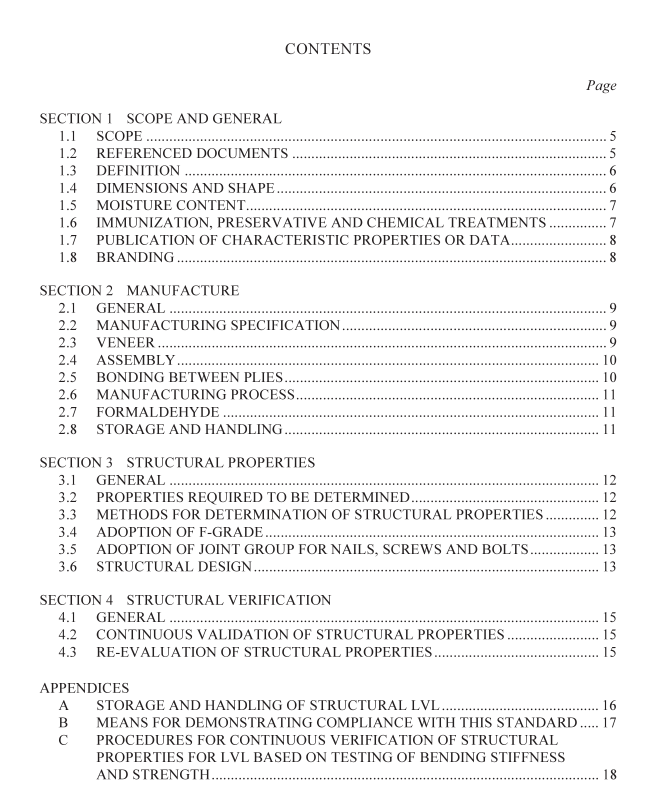AS NZS 4357.0 pdf download – Structural laminated veneer lumber Part 0: Specifications

AS NZS 4357.0 pdf download – Structural laminated veneer lumber Part 0: Specifications
2.1GENERAL
Structural LVL shall be manufactured in conformance with a manufacturing specificationthat defines and limits all variables likely to affect or correlate with structural performanceof that specific LVL product.
2.2 MANUFACTURING SPECIFICATION
The manufacturing specification shall set the limits on all variables that affect or correlatewith final product properties.Variables that influence the properties of LVL include—
(a)species;
(b)log diameter, log quality indices and geographical source,
(c)veneer density or veneer characteristics (e.g., notional E);
(d)veneer quality;
(e)veneer joints (type and frequency);
(f)veneer thickness;
(g)veneer arrangement;
(h)bond quality;
(imanufacturing process; and
(j)secondary processes and treatment.
NOTE: The above list is not intended to be exhaustive.
2.3VENEER
2.3.1 General
Structural LVL may be manufactured from veneer of any species,quality,density orcharacteristies, provided the manufacturing specification includes definition of the species,quality , density, and characteristics.
Where mixtures of species are used or where there are likely to be significant fluctuationsin the characteristics or density of veneer, any one of the following shall apply:
(a) Veneer shall be mixed in order to effectively randomize its inclusion throughout the
assembly.
(b)Veneer shall be separated according to its species,quality, density or characteristics,
and assembled into the matrix in some specified pattern.
(c)lf neither procedure is used, then the minimum strength species, and veneer of the
lowest quality, density or characteristics shall be used to manufacture material fromwhich a sample is drawn for testing and evaluation of the structural properties.
2.3.2Veneer quality
The minimum veneer quality shall be specified either as a standard veneer quality asdefined in AS/NZS 2269 or a non-standard veneer quality provided that the manufacturingspecification includes the definition of the non-standard minimum veneer quality coveringall characteristics defined in AS/NZS 2269.
2.3.3Veneer thickness
Veneer of any thickness may be used. The thickness used shall be included in thespecification. Where more than one thickness is used in a construction, then the location ofeach thickness in the assembly , shall be specified.
2.3.4 Veneer length
Veneer of any length may be used.However,the minimum and average lengths shall bespecified.
2.4ASSEMBLY2.4.1General
The assembly of structural LVL shall be defined in the manufacturing specification.
2.4.2 Construction
The construction of structural LVL containing cross-band veneers shall be balanced inregard to all properties affecting product stability.
Assemblies may contain layers other than wood veneer, such as plastics or metals, providedincorporation of such layers is taken into account in determination of structural propertiesand is compatible with the bond quality and durability requirements for the targetedapplication.
Sheets of veneer shall be free from any ferrous material such as clips and staples.
2.4.3Veneer joints
The veneer joints shall be as follows:
(a) The location, type and minimum spacing of veneer end joints shall be specified.
(b)For lap joints, the minimum and maximum overlap shall be specified.
(c)For scarf joints, the slope of scarf and alignment tolerances shall be specified.
(d)For butt joints, the maximum gap, and limit on overlap (if any), shall be specified.(e) Bonding of scarf or lap end joints shall be achieved by an adhesive complying with
type A bond requirements of AS 2754.1.
(f) Bond requirements for joints shall be the same as for the bonding between plies.NOTES:
1 lt is recommended that at least the two outer veneers be made continuous by jointing.
2Cross-banded veneers should preferably only be introduced between continuous long-bandveneers and be continuous across the full width of the LVL.
3 The process should be capable of successfully manufacturing the prescribed joint. This is
particularly significant in overlapped (crushed) joints or in butt joints where overlap ispermitted, which require extremely high specific pressures.
2.5BONDING BETWEEN PLIES
The bonding between plies shall be a Type A bond and shall comply with the followingrequirements:









